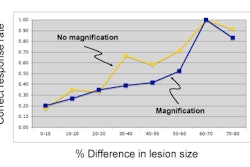SEATTLE - Lossy-compressed images at even mild compression ratios are highly distinguishable from lossless-compressed images, according to research presented Thursday at the annual meeting of the Society for Imaging Informatics in Medicine (SIIM).
"From a perceptual point of view, there are clear differences as you increase your compression levels when using lossy compression," said Elizabeth Krupinski, Ph.D., of the University of Arizona in Tucson.
Krupinski and Dr. Bradley Erickson, Ph.D., of the Mayo Clinic in Rochester, MN, presented the findings of SIIM's Transforming the Radiological Interpretation Process (TRIP) compression study during the 8th annual SIIM Research and Development Symposium.
SIIM's TRIP compression study sought to evaluate the perceptual differences of various 3D JPEG 2000 compression ratios on thin-slice multidetector-row CT (MDCT) data. For the purposes of the study, standard clinical exams of the chest, abdomen, and pelvis were employed, with a slice thickness of 0.625 mm to 1 mm. The image data was "clipped" to 12 bits, according to Erickson.
Using version 5.2 of the Kakadu JPEG 2000 compression algorithm, all images were compressed using lossless compression, as well as at lossy ratios of 8:1 at 12 bits, 12:1 at 12 bits, and 16:1 at 12 bits. Two randomly selected slices from each of the four datasets were used; the same slice was used for each ratio, Erickson said.
Four sequences of the image pairs were then created, including the original and one of the four compressed images. The pairs were presented in a random sequence, with each sequence having only one occurrence of a particular slice.
The images were presented to readers at three institutions: the Mayo Clinic, the University of Arizona, and Brigham and Women's Hospital/Harvard in Boston. All data preparation was performed and verified at one site, and the same datasets were used for all sites, Erickson said.
A special purpose application was developed to display the original and compressed images in a "flicker" mode. Readers were asked to select "different" or "no difference" for each image pair. Each reading session was approximately four weeks apart.
The image pairs were read on a Coronis Color 3MP DL display (Barco, Kortrijk, Belgium). The display was calibrated using Barco's DICOM Grayscale Standard Display Function (GSDF) calibration software.
At each of the three institutions, the image pairs were evaluated by two staff radiologists, two Ph.D.s, and two residents.
The mean percentage of "different" ratings was 2.3% for the lossless studies, 78% for the 8:1 ratio, 95% for the 12:1 ratio, and 99% for the 16:1-compressed studies, Krupinski said. Examining the findings by reader, the radiologists had a higher percentage of findings (38%) of no difference, compared with 28% for the Ph.D.s and 29% for the residents.
"It's difficult to say why this could happen, but it does look like there's a trend toward the radiologists being less sensitive or more tolerant to the differences," Krupinski said.
At the 12:1 and 16:1 ratios, the radiologists had significantly more "no difference" ratings than the residents and Ph.D.s (p < 0.05), she said.
"Whether they're less sensitive or more tolerant, it's impossible to say," she said. "But they do kind of ignore the differences or don't see them, perhaps, compared to the Ph.D.s and the residents. This may be a good thing, as maybe we can compress more (since) the radiologists don't notice."
There was no statistical difference between the sites, as well as by image type, Krupinski said.
While lossy compression was very perceptible in the study, it's important to note that perceived differences do not necessarily equate to diagnostic differences, she said.
As for a possible explanation for their findings, Krupinski said that the use of flicker induces perception of motion, which serves as a visual cue to notice differences between the images.
"You could really see as you flick back and forth between the original and the compressed version, and especially as you got to the higher compression levels, (that) there's apparent motion," she said. "The human visual system is incredibly keyed into motion, so anytime you saw this flickering in a sense anywhere in the image, you could obviously say it's different."
By Erik L. Ridley
AuntMinnie.com staff writer
May 15, 2008
Related Reading
Lossy compression performs well in abdominal CT images, January 13, 2008
Canadian research finds no loss with lossy compression, August 14, 2007
Enhanced DICOM objects, compression help with MDCT, MR challenges, March 23, 2007
Lossy 3D JPEG 2000 compression useful for abdominal MDCT, February 23, 2007
Canadian radiologists pursue lossy compression research, February 16, 2006
Copyright © 2008 AuntMinnie.com



















